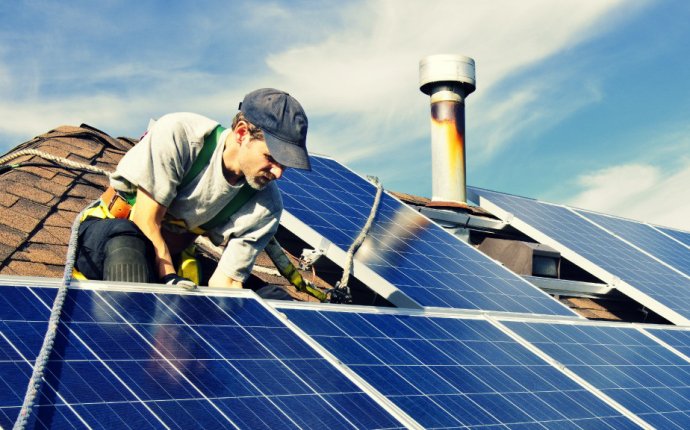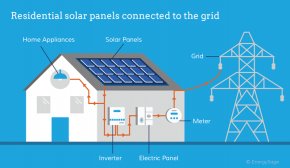
installing a solar panel system
In 1954, scientists at Bell Telephone discovered that silicon, an element found in sand, created an electric charge when it was exposed to sunlight. This discovery led to the development of solar cells that captured the sun’s energy and turned it into electricity. Since then, the technology has evolved, and solar power systems now provide incredibly attractive financial benefits for homeowners, businesses and non-profits across the United States.
Thanks to solar panels, we have access to an inexhaustible source of power – the sun. Throughout the day, the cells on your solar panels absorb the energy from sunlight. Circuits within the cells collect that energy and turn it into direct current (DC) electricity. The DC electricity is passed through a device called an inverter to convert it to the alternating current (AC) electricity used by most homes and businesses. You can use that electricity in your home, store it with a solar battery, or send it back to the grid.
How solar panels work in 3 steps
- Solar panels absorb sunlight with photovoltaic cells, creating direct current (DC) energy
- Solar inverters convert the DC electricity to usable alternating current (AC) energy
- AC energy flows through the home's electrical panel and is distributed accordingly
Solar panel diagram: how solar panels connect to the grid

Solar Panels
Solar panels collect and convert the sun’s energy into electricity. They are a key component of a solar panel system. Most commonly available panels today are either poly-crystalline or mono-crystalline solar panels.
The key differences between poly- and mono-crystalline panels are in efficiency and cost. Typically, mono-crystalline panels are more efficient (and thus more expensive) than poly-crystalline panels.
Not all panels are created equal: How to evaluate your solar panel options
To find the right solar panels for your home and your wallet, there are a variety of criteria to keep in mind, including product quality, durability, and long-term performance. Learn more about how to evaluate solar panels in the EnergySage Buyer's Guide for solar.
Inverters
The cells in your solar panels collect the sun’s energy and turn it into direct current (DC) electricity. Most homes and businesses, however, use alternating current (AC). Inverters change the DC electricity from your panels into usable AC electricity. There are three basic approaches to solar inverters.
String (or centralized) inverter: A single inverter is used to connect your entire array of solar panels to your electrical panel. String inverters are the least expensive inverter option, and cost less than micro-inverters. However, if one of the panels stops producing electricity, even due to temporary shading, it can bring down the performance of the whole system.
Micro-inverters: If you choose micro-inverters, one will be installed at each solar panel, which allows each panel to maximize production. If some of your panels are shaded at different times of day or if they aren’t all installed facing the same direction, micro-inverters will minimize performance issues. The cost of micro-inverters tends to be higher than the cost of string inverters.
Power optimizers: Systems that use power optimizers are a hybrid of micro-inverter and string inverter systems. Like micro-inverters, power optimizers are installed at each panel. However, instead of converting the DC electricity from the solar panels into AC electricity, the optimizers “condition” the DC electricity before sending it to a centralized inverter. Like micro-inverters, they perform well when one or more panels are shaded or if panels are installed facing different directions. Power optimizer systems tend to cost more than string inverter systems, but less than micro-inverter systems.
Racking and mounting systems
Racking and mounting systems are used to affix your solar panels either to your roof or to the ground. They also allow you to position your panels at an angle that is best for capturing the sun’s rays.
To perform at their best, solar panels should face south and be installed at an angle between 30 and 45 degrees (depending on how far you are from the equator). Panels facing east or west and at a pitch angle of five degrees or more will still work well, but will produce 10 to 20 percent less electricity than those installed under ideal conditions.









